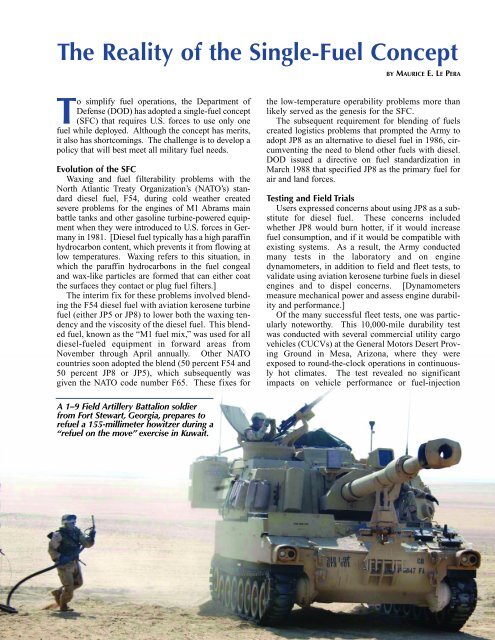Life-Cycle Management - Army Logistics University - U.S. Army
Life-Cycle Management - Army Logistics University - U.S. Army
Life-Cycle Management - Army Logistics University - U.S. Army
You also want an ePaper? Increase the reach of your titles
YUMPU automatically turns print PDFs into web optimized ePapers that Google loves.
The Reality of the Single-Fuel Concept<br />
To simplify fuel operations, the Department of<br />
Defense (DOD) has adopted a single-fuel concept<br />
(SFC) that requires U.S. forces to use only one<br />
fuel while deployed. Although the concept has merits,<br />
it also has shortcomings. The challenge is to develop a<br />
policy that will best meet all military fuel needs.<br />
Evolution of the SFC<br />
Waxing and fuel filterability problems with the<br />
North Atlantic Treaty Organization’s (NATO’s) standard<br />
diesel fuel, F54, during cold weather created<br />
severe problems for the engines of M1 Abrams main<br />
battle tanks and other gasoline turbine-powered equipment<br />
when they were introduced to U.S. forces in Germany<br />
in 1981. [Diesel fuel typically has a high paraffin<br />
hydrocarbon content, which prevents it from flowing at<br />
low temperatures. Waxing refers to this situation, in<br />
which the paraffin hydrocarbons in the fuel congeal<br />
and wax-like particles are formed that can either coat<br />
the surfaces they contact or plug fuel filters.]<br />
The interim fix for these problems involved blending<br />
the F54 diesel fuel with aviation kerosene turbine<br />
fuel (either JP5 or JP8) to lower both the waxing tendency<br />
and the viscosity of the diesel fuel. This blended<br />
fuel, known as the “M1 fuel mix,” was used for all<br />
diesel-fueled equipment in forward areas from<br />
November through April annually. Other NATO<br />
countries soon adopted the blend (50 percent F54 and<br />
50 percent JP8 or JP5), which subsequently was<br />
given the NATO code number F65. These fixes for<br />
A 1–9 Field Artillery Battalion soldier<br />
from Fort Stewart, Georgia, prepares to<br />
refuel a 155-millimeter howitzer during a<br />
“refuel on the move” exercise in Kuwait.<br />
BY MAURICE E. LE PERA<br />
the low-temperature operability problems more than<br />
likely served as the genesis for the SFC.<br />
The subsequent requirement for blending of fuels<br />
created logistics problems that prompted the <strong>Army</strong> to<br />
adopt JP8 as an alternative to diesel fuel in 1986, circumventing<br />
the need to blend other fuels with diesel.<br />
DOD issued a directive on fuel standardization in<br />
March 1988 that specified JP8 as the primary fuel for<br />
air and land forces.<br />
Testing and Field Trials<br />
Users expressed concerns about using JP8 as a substitute<br />
for diesel fuel. These concerns included<br />
whether JP8 would burn hotter, if it would increase<br />
fuel consumption, and if it would be compatible with<br />
existing systems. As a result, the <strong>Army</strong> conducted<br />
many tests in the laboratory and on engine<br />
dynamometers, in addition to field and fleet tests, to<br />
validate using aviation kerosene turbine fuels in diesel<br />
engines and to dispel concerns. [Dynamometers<br />
measure mechanical power and assess engine durability<br />
and performance.]<br />
Of the many successful fleet tests, one was particularly<br />
noteworthy. This 10,000-mile durability test<br />
was conducted with several commercial utility cargo<br />
vehicles (CUCVs) at the General Motors Desert Proving<br />
Ground in Mesa, Arizona, where they were<br />
exposed to round-the-clock operations in continuously<br />
hot climates. The test revealed no significant<br />
impacts on vehicle performance or fuel-injection<br />
40 JANUARY–FEBRUARY 2005







